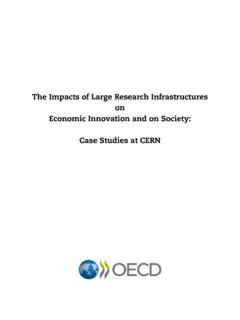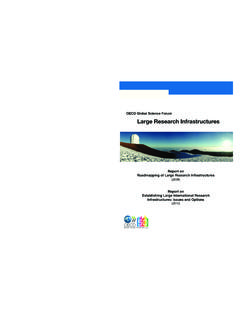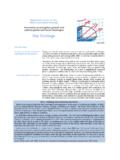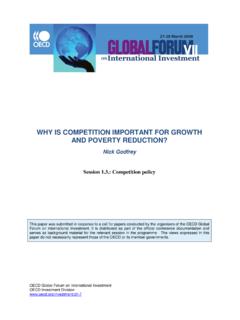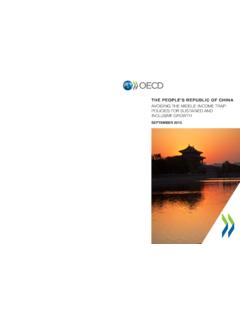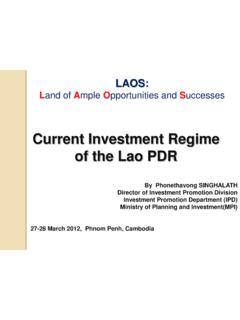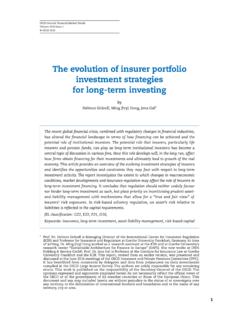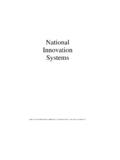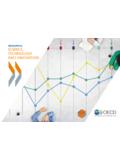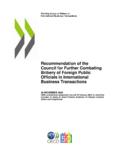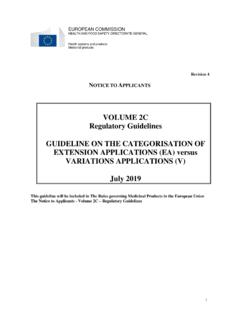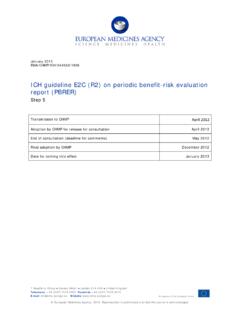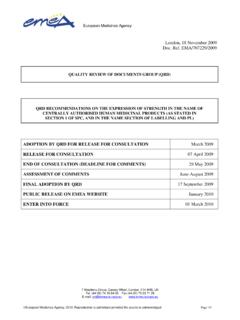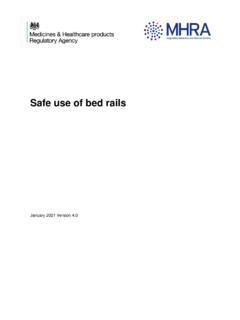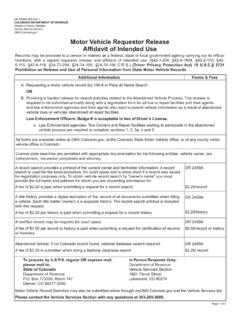Transcription of PRODUCT RISK ASSESSMENT PRACTICES OF …
1 Unclassified DSTI/CP/CPS(2014)6/FINAL Organisation de Coop ration et de D veloppement conomiques Organisation for Economic Co-operation and Development 19-Jan-2016 _____ English - Or. English DIRECTORATE FOR SCIENCE, TECHNOLOGY AND INNOVATION COMMITTEE ON CONSUMER POLICY Working Party on Consumer PRODUCT Safety PRODUCT RISK ASSESSMENT PRACTICES OF regulatory AGENCIES Summary of discussions at Workshops and Meetings of the OECD Working Party on Consumer PRODUCT Safety JT03389121 Complete document available on OLIS in its original format This document and any map included herein are without prejudice to the status of or sovereignty over any territory, to the delimitation of international frontiers and boundaries and to the name of any territory, city or area.
2 DSTI/CP/CPS(2014)6/FINAL Unclassified English - Or. English DSTI/CP/CPS(2014)6/FINAL 2 FOREWORD This report provides a summary of discussions held at workshops and meetings of the Working Party on Consumer PRODUCT Safety between 2012 and 2014 on regulatory agencies PRODUCT risk ASSESSMENT PRACTICES . This project was led by delegates of the Working Party from Australia. The report was approved by the Working Party on Consumer PRODUCT Safety at its 10th Session in May 2015. It was declassified by the Committee on Consumer Policy on 21 October 2015 at its 90th Session. The document is published under the responsibility of the Secretary-General of the OECD.
3 DSTI/CP/CPS(2014)6/FINAL 3 TABLE OF CONTENTS FOREWORD 2 Background 4 I. PRODUCT risk ASSESSMENT through the supply chain 4 PRODUCT risk assessments performed by suppliers 4 PRODUCT risk assessments performed by regulators 5 The international standard ISO 10377 6 II. WP goals in relation to PRODUCT risk ASSESSMENT 7 III. PRODUCT risk ASSESSMENT principles 8 IV. PRODUCT risk ASSESSMENT elements 9 Identifying the PRODUCT 10 Understanding the use of the PRODUCT 10 Scenario development 11 Severity of injury and potential health effects 11 Probability of harm occurring 12 Risk estimation 12 Risk evaluation 13 Risk evaluation factors 13 Combining risk evaluation factors with the estimated risk 14 V.
4 Tools and approaches 15 Risk ASSESSMENT in the EU 15 Risk ASSESSMENT in Australia 15 Risk ASSESSMENT in Canada 16 BIBLIOGRAPHY 18 DSTI/CP/CPS(2014)6/FINAL 4 PRODUCT RISK ASSESSMENT PRACTICES OF regulatory AGENCIES SUMMARY OF DISCUSSIONS AT WORKSHOPS AND MEETINGS OF THE OECD WORKING PARTY ON CONSUMER PRODUCT SAFETY Background This document summarises the material presented at workshops and meetings of the Working Party on Consumer PRODUCT Safety (WP) between 2012 and 2014 on PRODUCT risk ASSESSMENT as practised by regulatory agencies. More specifically, the report reflects WP discussions about regulatory agency risk prioritisation and triage, and PRODUCT risk ASSESSMENT more broadly.
5 The document summarises parts of those discussions from a regulator s perspective and does not represent the views of individual regulatory agencies. This is not a comprehensive review of the risk ASSESSMENT PRACTICES of the participating agencies but some similarities and differences are described. The report references the risk ASSESSMENT terminology used in the international standard ISO 10377:2013 Consumer PRODUCT safety Guidelines for suppliers. It reflects comments received from the WP, as well as from several independent experts, on PRODUCT risk ASSESSMENT from an industry perspective. While the report does not provide guidelines for assessing PRODUCT risk, it may be useful for regulators and industry experts and contribute to the body of knowledge in this area.
6 Some of the feedback from industry experts suggests that a guideline or checklist for risk ASSESSMENT could be a useful tool that might be developed in the future. It is the hope of the WP that this document might assist in any such endeavour. I. PRODUCT risk ASSESSMENT through the supply chain regulatory agencies and businesses use PRODUCT risk ASSESSMENT to determine whether action is required to reduce the risk that users might be injured using a PRODUCT . PRODUCT risk assessments performed by suppliers The ultimate responsibility for PRODUCT safety sits with suppliers. PRODUCT safety regulators have an oversight or governance role with responsibility for ensuring that suppliers comply with the law and supply products that present an acceptable safety risk to consumers.
7 If available to regulators, PRODUCT risk assessments performed by suppliers provide one source of information about risk issues. Risk assessments are performed by various suppliers at different stages of the supply chain. As illustrated in Figure 1, risk ASSESSMENT often starts during the design of the PRODUCT , in order to achieve safety by design. Suppliers of component parts and ingredients often conduct risk assessments and manufacturers may also conduct risk assessments of the raw materials that they receive. Manufacturers often conduct risk assessments in relation to their production, and brand owners, importers and retailers often conduct a risk ASSESSMENT of the final PRODUCT .
8 DSTI/CP/CPS(2014)6/FINAL 5 Figure 1. Pre-market and post-market risk ASSESSMENT D Source: Adapted from GS1 graphic. PRODUCT risk ASSESSMENT may be addressed or required under a range of voluntary safety standards relevant to particular products or types of products. In some jurisdictions, depending on the type of products and their role in the supply chain, suppliers may be required by law to conduct or hold PRODUCT risk assessments. Third parties may be engaged to assist in performing PRODUCT risk assessments.
9 This can vary, from a simple outsourcing arrangement to acquire appropriate expertise and specialist knowledge in risk ASSESSMENT , through to engaging an accredited test laboratory, conformity ASSESSMENT body or certification body to assess the PRODUCT . An individual supplier s risk ASSESSMENT of their own PRODUCT may not be relevant to similar products from other suppliers, because of differences in PRODUCT design, production, intended users, and risk tolerance. PRODUCT risk assessments performed by regulators In contrast, PRODUCT risk assessments performed by regulators often assess the risks presented by a PRODUCT category or type, supplied by a range of suppliers in a broad range of contexts.
10 PRODUCT risk assessments performed by regulators also tend to occur in a post-market context. Regulators are usually not involved in assessing the risk of products during design and development or for the purpose of demonstrating compliance with pre-market regulatory requirements such as prohibitions or mandatory standards. Some regulators prioritise safety issues as part of risk ASSESSMENT . This process is sometimes referred to as triage , initial ASSESSMENT or risk prioritisation . Regulators use the process to efficiently and objectively assess numerous reports of safety concerns from consumers, industry, and other sources.
